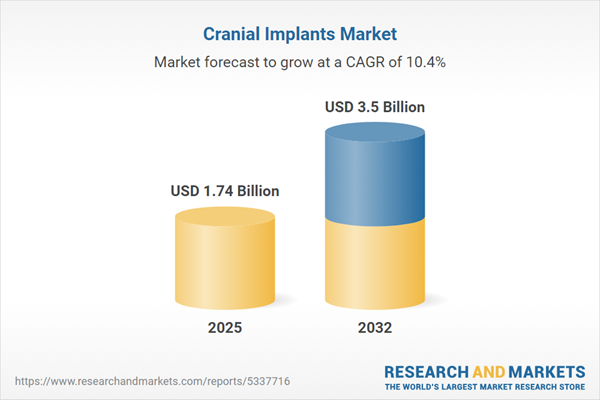Speak directly to the analyst to clarify any post sales queries you may have.
The cranial implants market is experiencing robust momentum, fueled by advancements in neurosurgical technology and rising demand for patient-specific solutions. Strategic transformation across surgical, clinical, and operational dimensions is redefining best practices for healthcare providers and device manufacturers alike.
Market Snapshot: Cranial Implants Market Size and Growth Trajectory
The cranial implants market grew from USD 1.58 billion in 2024 to USD 1.74 billion in 2025. This sector is set to maintain strong growth at a CAGR of 10.42%, with market value anticipated to reach USD 3.50 billion by 2032. Favorable drivers include heightened adoption of advanced surgical interventions, evolving patient expectations, and continued innovation across materials and design platforms.
Scope & Segmentation of the Cranial Implants Market
This analysis delivers comprehensive segmentation of the cranial implants market by product, material, indication, end user, distribution channel, and geography. Insights extend to leading technology use and evolving purchasing and deployment trends across regions.
- Product Type: Customized, Prefabricated
- Material: Ceramic, Metal, Polymer
- Indication: Congenital, Trauma, Tumor
- End User: Ambulatory Surgical Centers, Hospitals
- Distribution Channel: Offline, Online
- Geographical Coverage: Americas (North America: United States, Canada, Mexico; Latin America: Brazil, Argentina, Chile, Colombia, Peru), Europe, Middle East & Africa (Europe: United Kingdom, Germany, France, Russia, Italy, Spain, Netherlands, Sweden, Poland, Switzerland; Middle East: United Arab Emirates, Saudi Arabia, Qatar, Turkey, Israel; Africa: South Africa, Nigeria, Egypt, Kenya), Asia-Pacific (China, India, Japan, Australia, South Korea, Indonesia, Thailand, Malaysia, Singapore, Taiwan)
- Leading Companies: Stryker Corporation, Johnson & Johnson Medical Devices Companies, Medtronic plc, Zimmer Biomet Holdings Inc., Integra LifeSciences Holdings Corporation, B. Braun Melsungen AG, KLS Martin Group, Orthofix Medical Inc., Anika Therapeutics Inc., Exactech Inc.
Cranial Implants Market: Key Takeaways and Strategic Insights
- Advanced imaging modalities and 3D printing now enable greater implant customization, supporting precise anatomical reconstruction and favorable patient outcomes.
- Material science breakthroughs have resulted in new implant substrates that promote biocompatibility, reduce infection risk, and facilitate integration into clinical procedures.
- Surgeon and patient demand for improved cosmetic and functional results continues to drive innovation, with a shift from standard to individualized solutions.
- Broader access to digital platforms is reshaping procurement workflows, enhancing inventory visibility, and supporting rapid delivery to healthcare facilities.
- Collaborations between device manufacturers, research institutions, and engineering specialists are accelerating iterative design and product validation cycles, enhancing both safety and performance.
- Healthcare value-based models are encouraging integration of advanced implants into multidisciplinary care pathways, driving adoption and fostering improved surgical outcomes.
Tariff Impact: Navigating Changes in Global Supply Chains
Recent tariff adjustments in the United States have affected global sourcing strategies for cranial implant components. Manufacturers are reconfiguring procurement and production by diversifying supplier networks and establishing new regional manufacturing sites, ensuring product quality and pricing stability amidst regulatory shifts.
Research Methodology & Data Sources
This report is built on rigorous research methodologies, including thorough reviews of peer-reviewed scientific literature, regulatory documents, clinical trial outcomes, and manufacturing records. Structured interviews with neurosurgeons, biomedical engineers, and procurement specialists add qualitative context. Data has been cross-referenced from multiple sources to ensure reliability and industry relevance.
Why This Report Matters for Decision-Makers
- Gain actionable intelligence on the evolving landscape of cranial implant technologies, enabling effective investment and product development planning.
- Understand regional adoption patterns, supply chain challenges, and future demand drivers to anticipate market shifts and optimize commercial strategy.
- Benefit from segmentation analysis that empowers targeted marketing, regulatory planning, and resource allocation aligned to end-user priorities.
Conclusion
The cranial implants market is advancing rapidly through digital manufacturing, new biomaterials, and adaptive supply strategies. Stakeholders equipped with reliable insights will be positioned to respond to emerging trends and advance outcomes in cranial rehabilitation efficiently.
Additional Product Information:
- Purchase of this report includes 1 year online access with quarterly updates.
- This report can be updated on request. Please contact our Customer Experience team using the Ask a Question widget on our website.
Table of Contents
3. Executive Summary
4. Market Overview
7. Cumulative Impact of Artificial Intelligence 2025
Companies Mentioned
The companies profiled in this Cranial Implants market report include:- Stryker Corporation
- Johnson & Johnson Medical Devices Companies
- Medtronic plc
- Zimmer Biomet Holdings, Inc.
- Integra LifeSciences Holdings Corporation
- B. Braun Melsungen AG
- KLS Martin Group
- Orthofix Medical Inc.
- Anika Therapeutics, Inc.
- Exactech, Inc.
Table Information
| Report Attribute | Details |
|---|---|
| No. of Pages | 195 |
| Published | October 2025 |
| Forecast Period | 2025 - 2032 |
| Estimated Market Value ( USD | $ 1.74 Billion |
| Forecasted Market Value ( USD | $ 3.5 Billion |
| Compound Annual Growth Rate | 10.4% |
| Regions Covered | Global |
| No. of Companies Mentioned | 11 |









